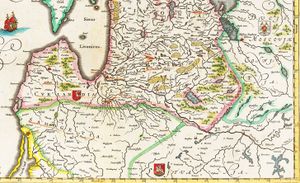ساموگيت
 قبائل البلطيق، حوالي سنة 1200م. | |
| إجمالي التعداد | |
|---|---|
| ح. 0.5 مليون في لتوانيا (تقدير) | |
| المناطق ذات التجمعات المعتبرة | |
| لتوانيا | |
| اللغات | |
| ساموگيت (لهجة)، اللغة اللتوانية الفصحى | |
| الدين | |
| الكاثوليكية | |
| الجماعات العرقية ذات الصلة | |
| Aukštaitians, Curonians |
الساموگيت (إنگليزية: Samogitians؛ بالساموگيتية: Žemaitē؛ لتوانية: Žemaičiai؛ باللاتڤية: Žemaiši؛ بالسلاڤية: Zhmud) هي جماعة فرعية من اللتوان تعيش في منطقة ساموگيتيا في لتوانيا. العديد منهم يتكلم اللغة الساموگيتية، التي تُعتبر أحياناً لهجة من اللغة اللتوانية.
Even though Samogitians are politically not considered to be an ethnic group, 2,169 people declared their ethnicity as Samogitian during the Lithuanian census of 2011, of whom 53.9% live in Telšiai County.[1]
التاريخ
في 13 يوليو 1260، انتصر الساموگيت نصر حاسماً على القوات المشتركة من الفرسان التيوتون من پروسيا و Livonian Order من ليڤونيا في معركة دوربه. Some 150 knights were killed, including Livonian Master Burchard von Hornhausen and Prussian Land Marshal Henrik Botel.[2]
Samogitians lived in western Lithuania and were closely related to Semigallians and Curonians. In 1413, they became the last group of Europeans to convert to Christianity. Samogitians were one of the three main nations of the Grand Duchy of Lithuania, Ruthenia, and Samogitia. In 1857, there were 418,824 people of Samogitian roots and 444,921 persons declared the Samogitian dialect as their mother tongue in 1897 in Kovno Governorate.[3] Currently Lithuania does not allow for declaration of Samogitian nationality in passports as it is not a recognized ethnicity.[4] In list of ethnic groups of Russia there is one person who declared himself with "Zhemaijty".[5]
Exonyms
Samogitians call themselves Žemaitē, although exonyms are used in different languages.
| اللغة | ساموگيتيا | ساموگيت |
|---|---|---|
| الساموگيتية | Žemaitėjė | žemaitē |
| Lithuanian | Žemaitija | žemaičiai |
| البلاروسية | Жамойць | жамойць |
| Yiddish | זאַמעט (Zámet) | זאַמעטער (Zámeter) |
| الإستونية | Žemaitija | Žemaidid |
| الهولندية | Samogitië | Samogitiërs |
| الفرنسية | Samogitie | samogitiens |
| الألمانية | Schameiten | Schameiten |
| الإيطالية | Samogizia | samogizi |
| اللاتڤية | Žemaitija | žemaiši |
| Polish | Żmudź | Żmudzini |
| Portuguese | Samogícia | samogícios |
| Russian | Жемайтия | жемайты |
| Spanish | Samogitia | samogitios |
| Swedish | Samogitien | Samogitier |
| Ukrainian | Жемайтія | жемайти |
الهامش
- ^ Statistics (في لتوانيا).
- ^ Ivinskis, Zenonas (1978). Lietuvos istorija iki Vytauto Didžiojo mirties (in الليتوانية). Rome: Lietuvių katalikų mokslo akademija. pp. 184–188. قالب:LCC.
- ^ Petrulis, Valdas (2005). "Žemaitijos etninės savimonės regiono erdvinė struktūra" (PDF). Geografijos metraštis. 38: 163–175. ISSN 0132-3156. Archived from the original (PDF) on 2011-07-22.
- ^ lrytas.lt (2007-06-04). "Žemaičio tautybė - vos porai dienų" (in Lithuanian). Retrieved 2007-11-23.
{{cite web}}: CS1 maint: unrecognized language (link) - ^ Perepis.ru (in Russian)
وصلات خارجية
- CS1 الليتوانية-language sources (lt)
- "Related ethnic groups" needing confirmation
- Pages using infobox ethnic group with unsupported parameters
- Articles using infobox ethnic group with image parameters
- Articles containing إنگليزية-language text
- Pages using Lang-xx templates
- Articles containing لتوانية-language text
- Articles with hatnote templates targeting a nonexistent page
- جماعات عرقية في لتوانيا
- ساموگيتيا

